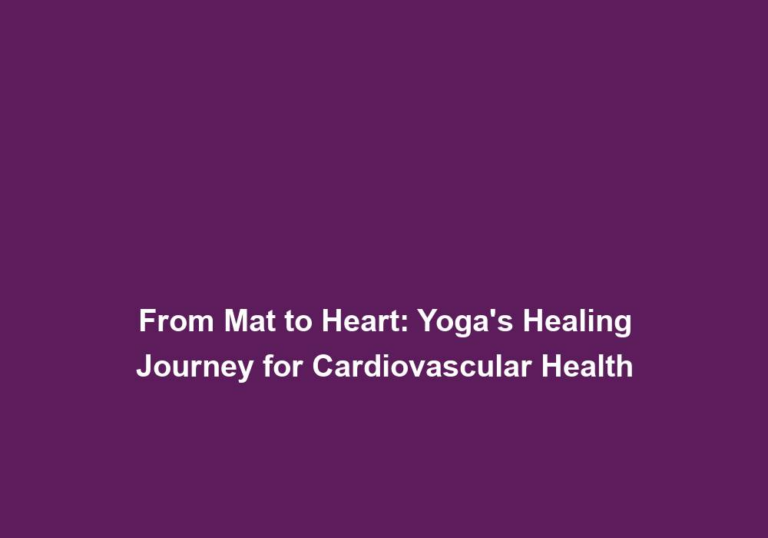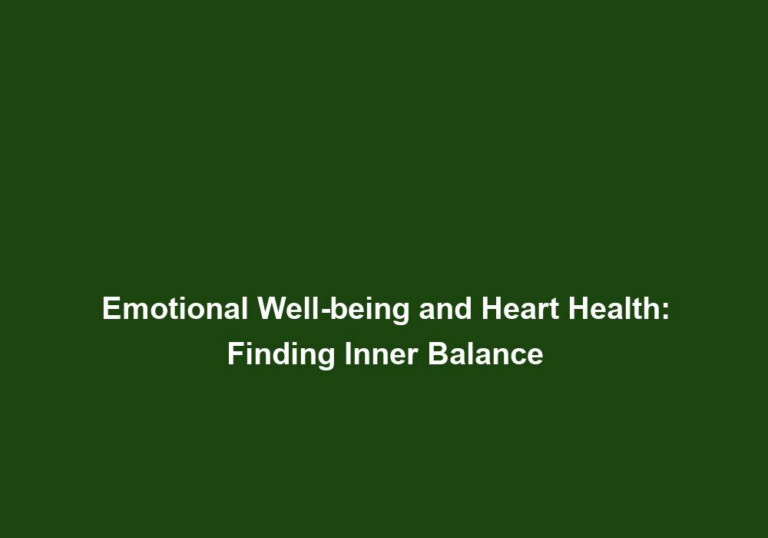Heart Health Revolution: Breakthroughs in Cardiology
The field of cardiology has witnessed remarkable breakthroughs in recent years, revolutionizing the way we approach heart health. These advancements have paved the way for improved prevention, diagnosis, and treatment of cardiovascular diseases. In this article, we will delve into some of the most significant breakthroughs in cardiology and explore how they are transforming the landscape of heart health.
1. Artificial Intelligence (AI) in Cardiology
Artificial Intelligence (AI) has made significant strides in various industries, and cardiology is no exception. AI algorithms can analyze large sets of cardiac data with incredible speed and accuracy, enabling early detection and prevention of heart diseases. These algorithms can spot patterns and predict outcomes, aiding physicians in making informed decisions about patient care.
Artificial Intelligence (AI) has revolutionized the field of cardiology by leveraging its ability to analyze large amounts of cardiac data quickly and accurately. By using AI algorithms, healthcare professionals can detect and prevent heart diseases at an early stage, leading to better patient outcomes. These algorithms have the capability to identify patterns in the data and predict potential outcomes, providing valuable insights for physicians to make informed decisions about patient care.
The use of AI in cardiology has proven to be highly beneficial in the detection and prevention of heart diseases. AI algorithms can analyze various types of cardiac data, including electrocardiograms (ECGs), echocardiograms, and medical imaging, with exceptional precision. This allows for the identification of subtle abnormalities and the early detection of cardiovascular conditions, such as arrhythmias, heart failure, and coronary artery disease.
Furthermore, AI algorithms can predict the likelihood of future cardiac events based on the analysis of patient data. This predictive capability enables physicians to develop personalized treatment plans and interventions to reduce the risk of adverse outcomes. By leveraging AI in cardiology, healthcare professionals can optimize patient care and improve long-term prognosis.
Some of the key applications of AI in cardiology include:
- Early Detection: AI algorithms can analyze multiple cardiac parameters simultaneously, enabling the early detection of heart diseases before symptoms manifest.
- Risk Stratification: AI can assess an individual’s risk of developing cardiovascular diseases based on their medical history, lifestyle factors, and genetic predisposition.
- Treatment Optimization: By analyzing large datasets of patient outcomes, AI algorithms can identify the most effective treatment strategies for specific cardiovascular conditions.
- Real-time Monitoring: AI-powered wearable devices can continuously monitor heart function and provide real-time feedback to individuals and healthcare providers.
2. Wearable Devices and Remote Monitoring
Wearable devices, such as smartwatches and fitness trackers, have become increasingly popular in recent years. These devices not only track physical activity but also provide valuable insights into heart health. Many advanced wearables are equipped with sensors that can monitor heart rate, blood pressure, and even detect irregularities in heart rhythms. This real-time data allows individuals to proactively manage their heart health and seek timely medical intervention if necessary.
Wearable devices have transformed the way individuals monitor and manage their heart health. With the advancement of technology, these devices have become more sophisticated and capable of providing accurate and real-time data on various cardiac parameters. Here are some key benefits of wearable devices in cardiology:
- Continuous Monitoring: Wearable devices can provide continuous monitoring of heart rate, allowing individuals to track their heart health throughout the day. This can be particularly useful for individuals with known cardiac conditions or those at risk of developing heart diseases.
- Early Detection of Abnormalities: Advanced wearable devices are equipped with sensors that can detect irregularities in heart rhythms, such as atrial fibrillation. Early detection of these abnormalities can prompt individuals to seek medical attention promptly, potentially preventing adverse events like strokes or heart attacks.
- Physical Activity Tracking: Wearable devices can track physical activity levels, providing individuals with insights into their overall fitness and cardiovascular health. Regular exercise is essential for maintaining a healthy heart, and wearable devices can serve as a motivating tool to encourage individuals to stay active.
- Remote Monitoring: Wearable devices enable remote monitoring of cardiac parameters, allowing healthcare providers to assess patients’ heart health without the need for in-person visits. This is particularly beneficial for individuals living in remote areas or those with limited access to healthcare facilities.
- Data-driven Insights: The data collected by wearable devices can be analyzed to provide personalized recommendations for improving heart health. These insights can help individuals make informed decisions about their lifestyle, diet, and exercise habits.
3. Precision Medicine
Precision medicine is an emerging approach that takes into account individual variability in genes, environment, and lifestyle for disease prevention and treatment. In cardiology, precision medicine aims to identify genetic markers associated with specific cardiovascular conditions to personalize treatment plans. By tailoring therapies to an individual’s unique genetic makeup, physicians can achieve better treatment outcomes and minimize side effects.
Precision medicine has revolutionized the field of cardiology by shifting the focus from a one-size-fits-all approach to a more personalized and targeted treatment strategy. By considering an individual’s genetic makeup, lifestyle factors, and environmental influences, healthcare professionals can develop tailored treatment plans that are more effective and have fewer side effects.
In the context of cardiology, precision medicine involves the identification of genetic markers associated with various cardiovascular conditions. By analyzing an individual’s genetic profile, physicians can gain insights into their susceptibility to certain heart diseases, such as coronary artery disease, heart failure, or arrhythmias. This information allows for the customization of treatment plans based on the individual’s genetic predisposition, optimizing the effectiveness of therapies and improving patient outcomes.
Precision medicine in cardiology offers several advantages:
- Risk Assessment: Genetic testing can identify individuals at a higher risk of developing certain cardiovascular conditions, allowing for early interventions and preventive measures.
- Targeted Therapies: Precision medicine enables the selection of medications and treatment approaches that are most likely to be effective based on an individual’s genetic profile.
- Minimization of Side Effects: By tailoring treatment plans to an individual’s genetic makeup, physicians can minimize the risk of adverse reactions and side effects.
- Improved Prognosis: Precision medicine allows for a more accurate prediction of disease progression and prognosis, guiding healthcare professionals in making informed decisions about long-term management.
Precision medicine is a rapidly evolving field, and ongoing research and advancements in genomic technology will further enhance its application in cardiology. As genetic testing becomes more accessible and affordable, precision medicine has the potential to transform the way cardiovascular diseases are diagnosed and treated.
4. Minimally Invasive Procedures
Advancements in technology have led to the development of various minimally invasive procedures in cardiology. These procedures offer an alternative to traditional open-heart surgeries, significantly reducing recovery time and complications. Techniques such as angioplasty, stenting, and transcatheter aortic valve replacement (TAVR) have revolutionized the treatment of coronary artery disease and structural heart conditions.
Minimally invasive procedures have transformed the field of cardiology by providing less invasive alternatives to traditional open-heart surgeries. These procedures involve accessing the heart through small incisions or blood vessels, reducing the need for large surgical incisions and lengthy hospital stays. Here are some key advancements in minimally invasive procedures in cardiology:
- Angioplasty: Angioplasty is a procedure used to open blocked or narrowed coronary arteries. During the procedure, a thin catheter with a balloon at the tip is inserted into the affected artery. The balloon is then inflated to compress the plaque and restore blood flow. In some cases, a stent may be inserted to keep the artery open after the balloon is deflated.
- Stenting: Stenting is often performed in conjunction with angioplasty. A stent is a small mesh tube that is inserted into the artery to provide structural support and maintain blood flow. Stents can be coated with medication to prevent the reoccurrence of blockages.
- Transcatheter Aortic Valve Replacement (TAVR): TAVR is a minimally invasive alternative to open-heart surgery for patients with severe aortic valve stenosis. During the procedure, a new valve is implanted through a catheter that is inserted into the blood vessels. This eliminates the need for a large chest incision and the use of a heart-lung machine.
Minimally invasive procedures offer several benefits compared to traditional open-heart surgeries:
- Reduced Recovery Time: Minimally invasive procedures typically require shorter hospital stays and offer quicker recovery times compared to open-heart surgeries. This allows patients to return to their normal activities sooner.
- Lower Risk of Complications: Minimally invasive procedures are associated with a lower risk of complications, such as infections and bleeding, compared to open-heart surgeries.
- Less Scarring: The small incisions used in minimally invasive procedures result in smaller scars compared to the large incisions required for open-heart surgeries.
- Improved Quality of Life: Minimally invasive procedures minimize the physical and emotional toll on patients, allowing them to resume their daily activities with less disruption.
The development of minimally invasive procedures has transformed the treatment of cardiovascular diseases, offering patients safer and more efficient alternatives to traditional open-heart surgeries. Continued advancements in technology and techniques will further expand the applications of minimally invasive procedures in cardiology.
5. Gene Therapy
Gene therapy holds great promise for the future of cardiology. This innovative approach involves introducing genetic material into a patient’s cells to prevent or treat disease. In the context of cardiovascular health, gene therapy aims to correct genetic mutations that contribute to heart diseases. While still in its early stages, gene therapy has shown encouraging results in preclinical and clinical trials, offering hope for more targeted and efficient treatments in the future.
Gene therapy has the potential to revolutionize the treatment of cardiovascular diseases by targeting the underlying genetic causes of heart conditions. By introducing specific genes or modifying existing ones, gene therapy aims to correct genetic mutations associated with heart diseases. Here are some key aspects of gene therapy in cardiology:
- Gene Delivery: Gene therapy involves the delivery of therapeutic genes into the patient’s cells. This can be achieved through various techniques, such as viral vectors, non-viral vectors, or genome editing tools like CRISPR-Cas9.
- Targeted Genetic Modification: Gene therapy targets specific genes or genetic pathways that contribute to the development or progression of cardiovascular diseases. By correcting these genetic abnormalities, gene therapy aims to restore normal heart function.
- Potential Applications: Gene therapy holds promise for the treatment of various cardiovascular conditions, including genetic disorders like hypertrophic cardiomyopathy and familial hypercholesterolemia, as well as acquired conditions like heart failure and coronary artery disease.
- Challenges and Future Directions: Despite promising results in preclinical and early clinical trials, gene therapy in cardiology still faces challenges related to safety, delivery efficiency, and long-term effectiveness. Ongoing research and advancements in gene editing technologies will address these challenges and pave the way for more targeted and efficient gene therapies.
Gene therapy offers several potential benefits for the treatment of cardiovascular diseases:
- Disease Modification: Gene therapy has the potential to modify the course of cardiovascular diseases by addressing the underlying genetic abnormalities. This could lead to long-term disease management and improved outcomes.
- Personalized Treatment: Gene therapy can be tailored to an individual’s specific genetic makeup, allowing for personalized treatment plans based on their unique genetic profile.
- Reduced Side Effects: By targeting the underlying genetic causes of heart diseases, gene therapy has the potential to minimize side effects associated with traditional treatment approaches, such as medications or invasive procedures.
- Future Perspectives: As research in gene therapy continues to advance, ongoing clinical trials and technological innovations will further enhance the safety and efficacy of gene therapies in cardiology, offering hope for more effective treatments.
6. Telemedicine in Cardiology
Telemedicine has gained significant traction in recent years, facilitating remote consultations and monitoring for patients with cardiovascular conditions. This technology allows patients to connect with healthcare professionals using telecommunication tools, eliminating geographical barriers and ensuring timely access to expert care. Telemedicine not only improves patient convenience but also enables early detection of potential cardiac complications, leading to better outcomes.
Telemedicine has transformed the way cardiovascular care is delivered by leveraging technological advancements to provide remote consultations and monitoring. Here are some key aspects of telemedicine in cardiology:
- Remote Consultations: Telemedicine enables patients to connect with cardiologists and other healthcare professionals remotely, eliminating the need for in-person visits. This is particularly beneficial for individuals living in remote areas or those with limited mobility.
- Real-time Monitoring: Telemedicine platforms can integrate with wearable devices and home monitoring equipment, allowing healthcare providers to remotely monitor patients’ cardiac parameters, such as heart rate, blood pressure, and oxygen saturation.
- Timely Intervention: Remote monitoring of cardiac parameters enables early detection of potential complications and abnormalities. Healthcare providers can intervene promptly and adjust treatment plans accordingly, reducing the risk of adverse events.
- Patient Education: Telemedicine platforms can provide educational resources and information about cardiac conditions, empowering patients to actively participate in their own care and make informed decisions about their lifestyle and treatment options.
The benefits of telemedicine in cardiology include:
- Improved Access to Care: Telemedicine eliminates geographical barriers and improves access to specialized cardiac care for individuals living in remote areas or those with limited transportation options.
- Cost Savings: Telemedicine reduces the need for travel and in-person visits, resulting in cost savings for both patients and healthcare systems.
- Enhanced Patient Convenience: Telemedicine enables patients to receive expert cardiac care from the comfort of their own homes, reducing the need for time-consuming visits to healthcare facilities.
- Early Detection and Intervention: Remote monitoring allows for the early detection of potential cardiac complications, enabling timely intervention and preventing adverse events.
- Continuity of Care: Telemedicine facilitates ongoing communication between patients and healthcare providers, ensuring continuity of care and timely adjustments to treatment plans.
Telemedicine will continue to play a significant role in the delivery of cardiovascular care, particularly in remote or underserved areas. As technology evolves and becomes more integrated with healthcare systems, telemedicine has the potential to improve access to specialized cardiac care and enhance patient outcomes.
7. Regenerative Medicine
Regenerative medicine aims to restore or replace damaged heart tissue through the use of stem cells or tissue engineering techniques. By harnessing the regenerative potential of the human body, researchers are exploring innovative approaches to repair and regenerate heart muscle damaged by heart attacks or other cardiac conditions. While still in its early stages, regenerative medicine holds immense promise for the future of cardiology and may revolutionize the treatment of heart diseases.
Regenerative medicine has the potential to revolutionize the treatment of heart diseases by harnessing the regenerative capabilities of the human body. Researchers are exploring various approaches to repair and regenerate damaged heart tissue, including the use of stem cells, tissue engineering, and biomaterials. Here are some key aspects of regenerative medicine in cardiology:
- Stem Cell Therapy: Stem cells, which have the ability to differentiate into various cell types, can be used to regenerate damaged heart tissue. These cells can be derived from various sources, including bone marrow, adipose tissue, or induced pluripotent stem cells (iPSCs).
- Tissue Engineering: Tissue engineering involves creating functional heart tissue in the laboratory using a combination of cells, biomaterials, and growth factors. These engineered tissues can be used to replace damaged or







